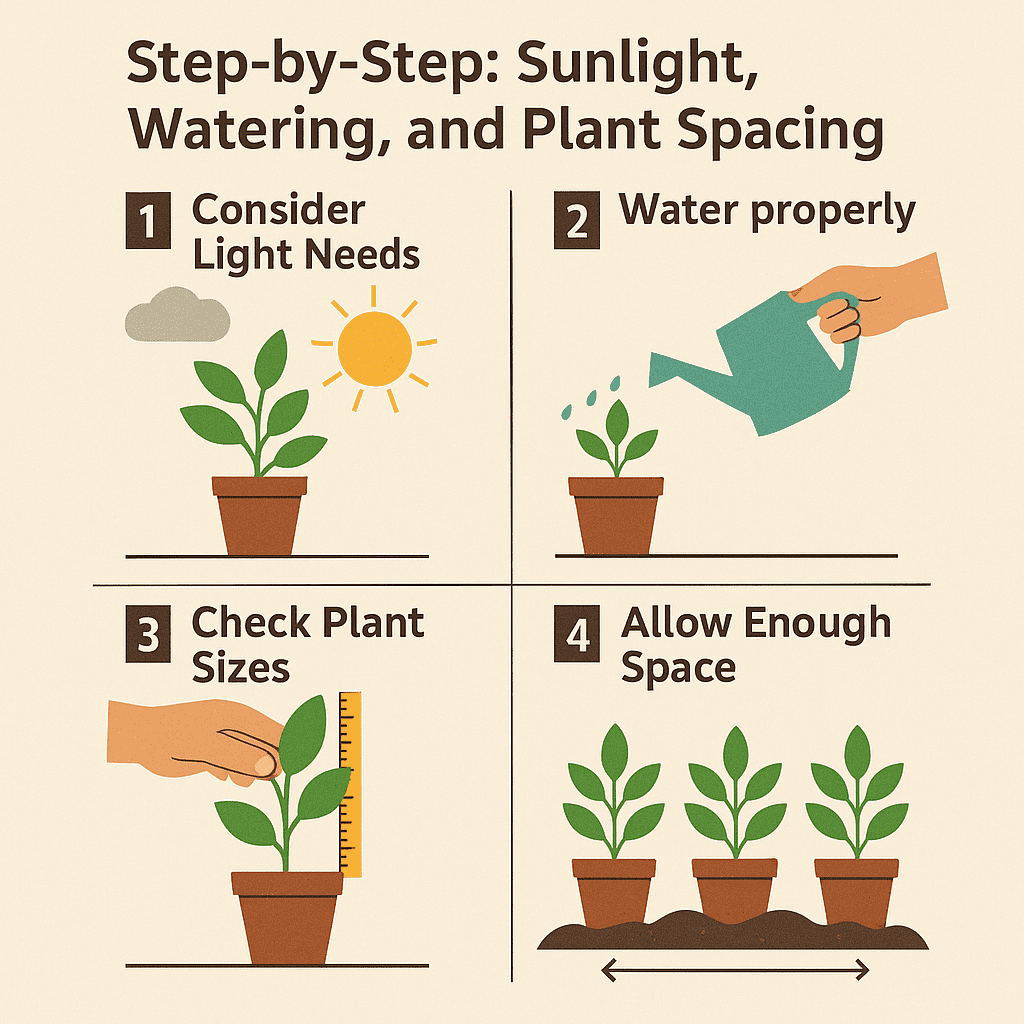Starting a garden can be incredibly rewarding, but it also comes with its fair share of challenges. If you’re just beginning, understanding the basics of sunlight, watering, and plant spacing is essential for growing healthy, vibrant plants. These three factors form the foundation of any successful garden and can significantly influence your results.
This beginner’s guide breaks down each element in simple, practical terms so you can build your confidence and grow a thriving garden—whether you’re planting vegetables, herbs, or flowers.
Why These Three Basics Matter
Every plant has specific needs when it comes to light, moisture, and space. If even one of these conditions is off, it can lead to slow growth, diseases, or even death. Understanding how to balance sunlight, watering, and plant spacing will help you avoid common pitfalls and give your plants the best chance to flourish.
Understanding Sunlight: Choosing the Right Spot
Sunlight is the plant’s primary energy source through the process of photosynthesis. However, not all plants require the same amount of sun.
Types of Sunlight Conditions
- Full Sun: At least 6 hours of direct sunlight daily. Ideal for tomatoes, peppers, sunflowers, and lavender.
- Partial Sun/Partial Shade: 3 to 6 hours of sunlight. Great for lettuce, spinach, peas, and many herbs.
- Full Shade: Less than 3 hours of direct sun. Suitable for ferns, hostas, and impatiens.
Tips for Getting Sunlight Right
- Observe your garden space at different times to determine how much sunlight each area receives.
- Use containers or raised beds to relocate plants if necessary.
- Rotate pots or planters regularly to ensure even exposure.
Mastering Watering Techniques: Frequency and Method
Water is essential for transporting nutrients and maintaining plant structure. Yet, overwatering and underwatering are two of the most common mistakes among beginners.
Signs You’re Watering Incorrectly
- Overwatering: Yellowing leaves, root rot, and mold.
- Underwatering: Wilting, dry soil, and brittle leaves.
How to Water Properly
- Check soil moisture before watering. Stick your finger about an inch into the soil. If it feels dry, it’s time to water.
- Water deeply but less frequently to encourage deeper root growth.
- Time of day matters: Water early in the morning or late afternoon to avoid evaporation.
- Use mulch around plants to retain moisture and regulate temperature.
Watering Tools
- Watering can for small gardens
- Hose with a spray nozzle for medium spaces
- Drip irrigation for large or raised beds
Getting Plant Spacing Right: Why It Matters
Crowding your plants is a recipe for problems like disease spread, stunted growth, and limited access to nutrients and sunlight.
Read the Label
Every seed packet or plant tag includes spacing information. Always follow these guidelines unless you’re experienced with intensive gardening methods.
General Spacing Guidelines
- Leafy greens: 6–8 inches apart
- Root vegetables: 2–4 inches apart for carrots and radishes; 12 inches for beets
- Tomatoes and peppers: 18–24 inches apart
- Herbs: 8–12 inches apart depending on growth size
Spacing Methods
- Grid layout: Divide your garden into squares and assign space per plant.
- Row planting: Traditional method with space between rows and plants.
- Companion planting: Combine plants that benefit each other (e.g., basil near tomatoes).
Putting It All Together: Step-by-Step Setup
Step 1: Choose a Sunny Location
Use a compass or sun-tracking app to find your sunniest spot. Remember, southern-facing areas typically get the most light.
Step 2: Test Your Soil
Use a basic soil test kit to assess pH and drainage. Amend with compost if necessary.
Step 3: Plan Your Layout
Sketch your garden or use a free online garden planner. Mark where each plant will go based on its light and spacing needs.
Step 4: Install Irrigation or Water Plan
Decide whether you’ll water manually or install a drip system. Group plants with similar water needs.
Step 5: Monitor and Adjust
Keep a garden journal. Note how plants respond and adjust watering or location as needed.

Common Beginner Mistakes and How to Avoid Them
- Ignoring plant labels: Always check light and spacing requirements.
- Overwatering: Wait until the soil dries out before watering again.
- Planting too close: Give plants the room they need to thrive.
- Forgetting about mulch: Mulch saves water and reduces weeds.
- Not rotating crops: Change planting areas each season to reduce disease.
Where to Buy Garden Supplies
Looking for reliable tools, soil testers, or watering accessories? Shop beginner gardening tools on Gardener’s Supply. Their selection is great for first-time growers and eco-conscious shoppers.
Want More Beginner Gardening Tips?
If you’re just starting out, don’t miss our article on Easy Vegetables to Grow for First-Time Gardeners — a perfect follow-up to apply your new skills.
Want to take the next step? Learn how to start seeds indoors with our complete beginner guide to indoor seed starting.
Conclusion: Build a Healthy Garden from the Ground Up
Learning how to manage sunlight, watering, and plant spacing may seem basic, but it’s the foundation for every successful garden. By mastering these three pillars, you set yourself up for fewer mistakes, stronger plants, and better harvests.
Save this guide for your next planting weekend — or share it with a friend who’s just starting their gardening journey!
FAQ: Sunlight, Watering, and Plant Spacing
Q1: Can I grow vegetables indoors if I don’t have much sunlight?
Yes. Use grow lights designed for indoor gardening and choose plants like lettuce, spinach, or herbs that need less light.
Q2: How often should I water my plants?
It depends on the plant, soil, and climate. As a general rule, check soil moisture regularly and water deeply when dry.
Q3: What if I don’t follow the spacing guidelines exactly?
Plants may still grow, but they will likely be smaller and more prone to disease. Proper spacing ensures healthy development and air circulation.
Need quality gardening tools, moisture meters, or grow lights? Find beginner-friendly gardening supplies at Gardener’s Supply Company to get started with confidence.
Written by Kate Smith | Plant Care Enthusiast & Urban Gardener
